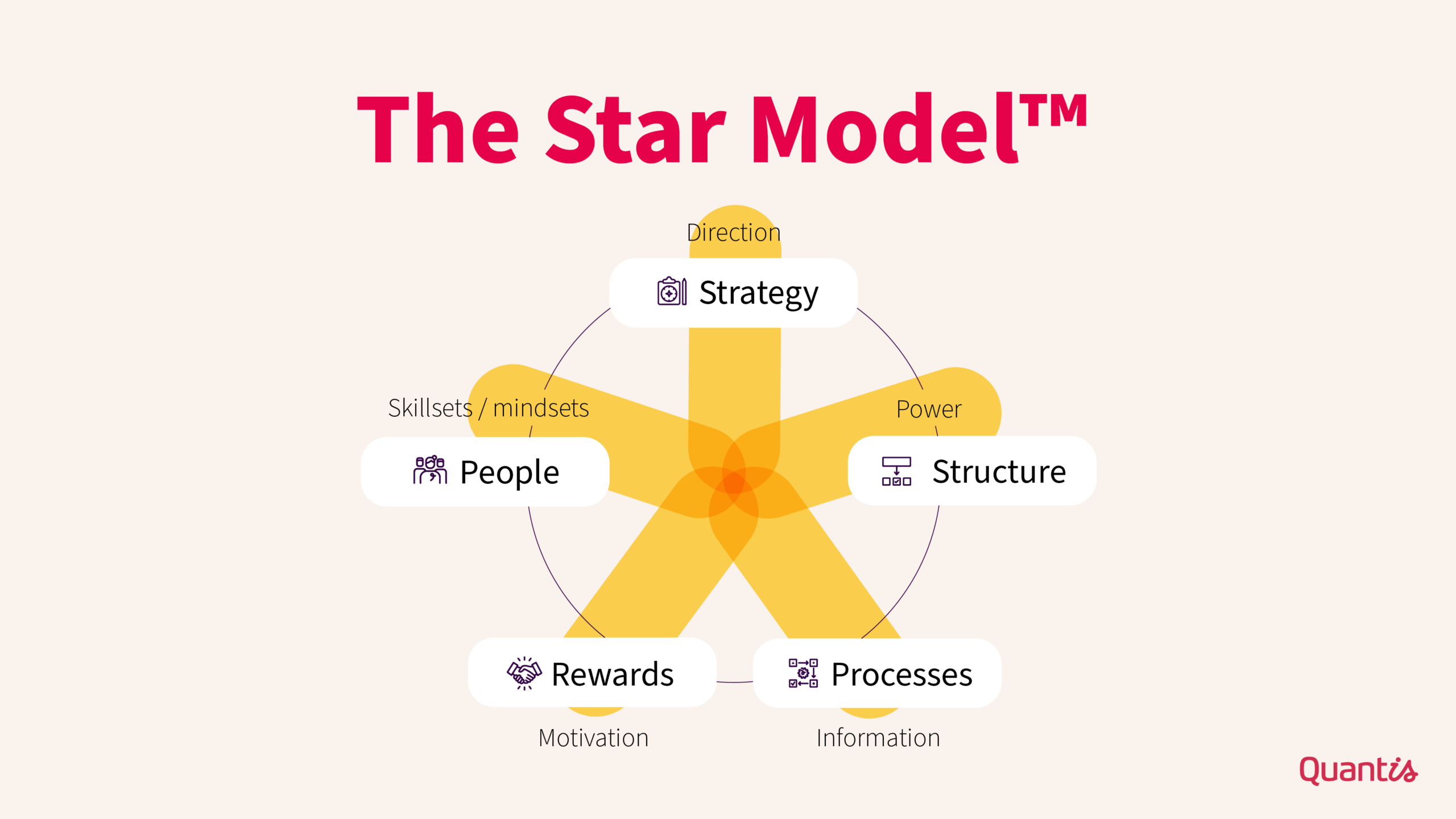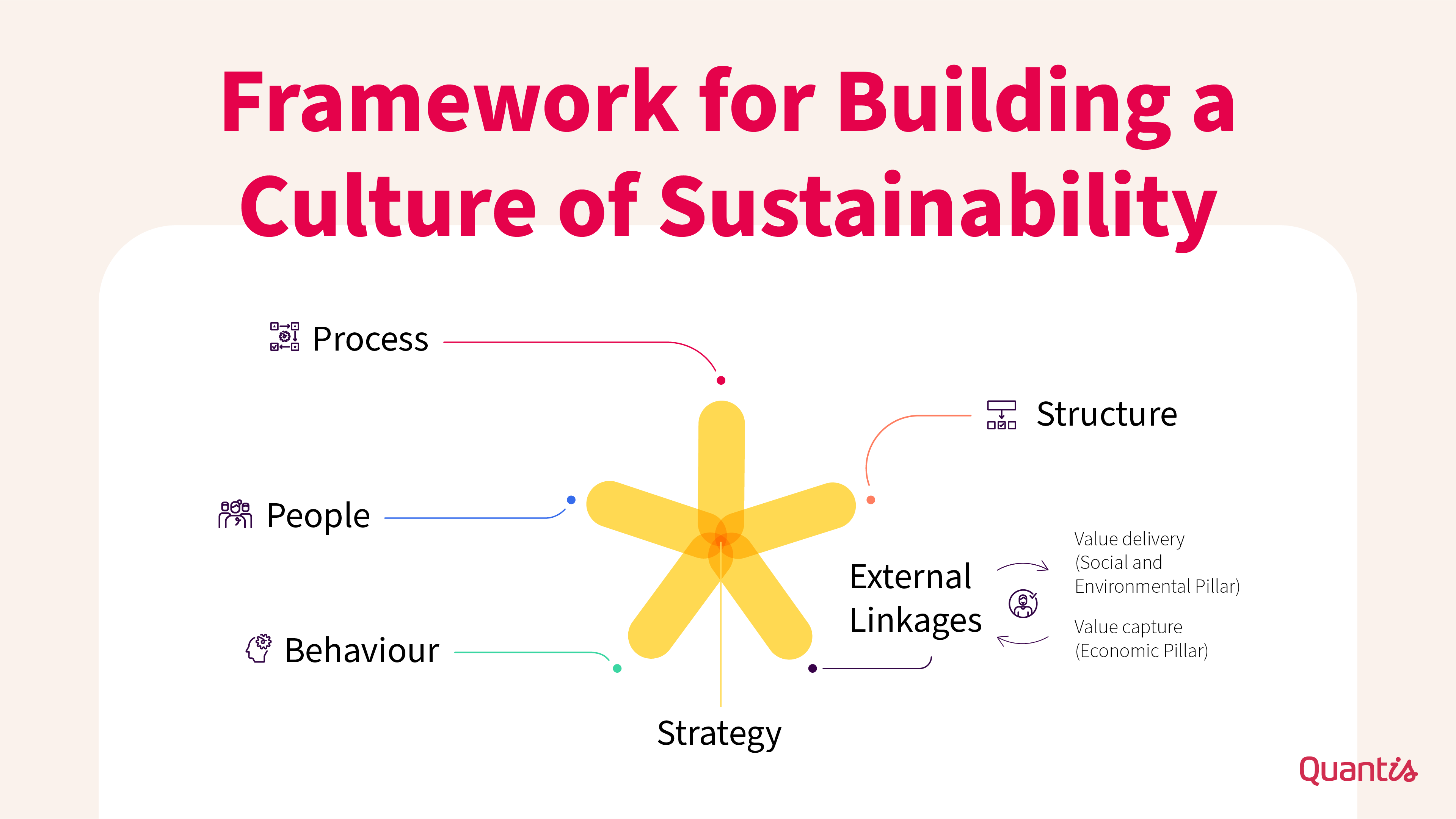This is the second in a two-part series exploring the role of organizational culture in determining a company’s success or failure in delivering on its sustainability ambitions. Read part one.
In brief:
- Companies that build strong cultures of sustainability create environments conducive to sustainable business transformation, and thus position themselves to deliver on sustainability commitments.
- Many companies are hyper focused on collecting and analyzing data and overlook organizational culture as an effective lever of change.
- Changing corporate culture is a notoriously difficult task. Companies are often resistant and slow to change, and there is a lack of guidance on how to create strong sustainability cultures.
- To make sustainability a core part of company culture, organizations must address five key elements: strategy, structure, processes, people and rewards.
- Leaders will need to create a new vision for the future, perform an honest assessment of where things currently stand, build internal capacity, remove roadblocks and reward and praise the right behaviors.
Embedding sustainability into organizational culture is a prerequisite for transformation, but its potential as a catalyst for change is often overlooked.
Though the two are of equal importance, culture doesn’t have the same star power as data, which is wrapped up in notions of innovation and progress. Things we can see. As humans, we’re innately drawn to the factual and concrete. It’s likely why so many companies spend an enormous amount of time and resources to fill in data gaps, even when enough information is available to carve a clear path forward. Culture, on the other hand, is all about the intangible — beliefs, behaviors and values.
Changing corporate culture for the better is also notoriously difficult. Organizations are often resistant and slow to change. And many contain corporate cultures that, at their core, aren’t conducive to becoming strong sustainability cultures. Compounding these challenges is the lack of a clear framework or guidance for creating strong sustainability cultures that can support (and reinforce) sustainability-oriented business models. The concept of sustainability culture sustainability is, after all, still relatively new.
A solution, however, might be found in the Star Model [Figure 1], a framework created by the late Dr. Jay Galbraith, one of the world’s leading experts on organizational design.

The Star Model: A framework for organizational design for sustainability
Galbraith’s Star Model outlines the five elements said to be essential to changing the culture of an organization — strategy, structure, processes, people and rewards. Recent studies suggest that the framework can be used to help companies embed sustainability into their organizational culture, especially if it’s expanded to include external linkages (the different players outside a firm that impact the economic, social, and environmental value a company creates for people and the planet) [Figure 2]. Figure 2

Strategy: determining what to do and how
Your strategy drives your business model and determines your direction, specifying what you want to achieve (goals, objectives and targets) and how you want to get there (values, purpose and mission). Of course, to determine what it’ll take to achieve your goals, you first need to conduct an honest assessment of where you are.
Strategy is at the heart of the Star Model because it establishes useful criteria for making trade-offs and choosing among alternative options in the remaining elements of organizational design. To shape a strong sustainability culture, sustainability must be a core element of your strategy, rather than sit at the periphery.
Structure: determining power and influence
Your structure determines where decision makers sit within the hierarchy of your organization and who has responsibility for which activities and goals.
To ensure that sustainability is baked into different roles within an organization, advancing sustainability should be shared across the business, with overall responsibility at an executive level. The roles and responsibilities of each department and function should be clearly defined and widely understood. Each team member should be able to answer the question, “How do I contribute to our sustainability goals and vision?”
Building cross-functional connections and networks of value creation are also needed to organize for sustainability.
Processes: how information is shared and communicated
If structure is the anatomy of an organization, then processes are its physiology. This element refers to how things function, for example, the process for collecting the data needed to inform sustainability reporting, or how funds are allocated to energy efficiency projects or supplier engagement programs.
Without good processes, it’s hard for people to access the information they need to make the right decision, such as highlighting inefficiencies and closing resource loops. An iterative process that identifies ways to continuously improve sustainability performance is key to business transformation.
Rewards: encouraging the behavior you want repeated
Rewarding employees for their behavior and actions can help align individual and corporate goals. People must learn to think and make decisions differently, incorporating sustainability into their daily work activities. At the senior level, executive bonuses linked to sustainability related KPIs can have a positive impact.
Elsewhere, people should be made to feel like they are contributing to the overall cause. As Tom Bateman, a management professor at the McIntire School of Commerce at the University of Virginia, says: “[People] need the knowledge, information, competence and power to make the right choices.”
People: the right people behave in the right way
Never underestimate the power of HR in leading business transformation. With people in your organization that truly understand your purpose, values and mission — and want to contribute meaningfully — you can accelerate your sustainability performance. This can be achieved through smart recruitment or providing appropriate onboarding, training, workshops and engagement activities for employees to ensure they have the right skills and knowledge in place to be effective change agents.
But it’s not just about having the right internal employees. All of your stakeholders, from suppliers and distributors to investors and NGOs, should be aligned with your strategy.
5 steps to develop a strong culture of sustainability
Though most CEOs agree that sustainability is important to their company’s future, many struggle to build it into their day-to-day operations.
The Star Model may pinpoint the key elements for changing organizational culture, but it doesn’t provide a “how-to guide” for actually embedding sustainability into your company’s strategy, structure, processes, etc.
To demystify the process, we’ve outlined the five key steps we take with clients to help them shape cultures capable of driving sustainable transformation.
Step 1: Create a new vision for the future.
Without a destination in mind, it’s impossible to pave a clear path forward. Vision provides this.
But your company’s current vision won’t be able to produce the outcomes you’re after. It’s purpose-built for different aspirations. New ambitions require a new vision — so it’s back to the drawing board.
The first action item: a visioning exercise. You’ll need to gather all the right people around the table — and if you don’t know who they are, you need to find out. Perform some “organizational soul-searching” to answer these key questions:
- Who are we as an organization? What is our purpose?
- What is our mindset and behavior?
- How would people describe us as a group?
- Is this who we want to be? As an individual, is this what I want too?
- When we envision the company we’re working at, what do we want it to look like in 2, 5 or even 10 years?
- What is the narrative we’d like to have in the future? How will that change from where we are today?
- Why do we need to change? What happens if we don’t?
- What are the principles of this vision?
- Do we have full executive support to realize this vision?
Step 2: Get a cultural baseline.
Determine how sustainability is currently “lived” in your organization. Conduct an assessment on the perception of the organization’s sustainability position among peers and across your industry. Get a sense of how critical sustainability is perceived to be to the success of the organization. This is particularly crucial for workers outside of sustainability functions. Do they feel they are contributing to the organization’s sustainability goals?
Above all else, be realistic. Beware of the gap between how the culture is officially described and how things really are. Also pay particular attention to the “deep culture” vs. the “surface culture.” The devil is in the details of “how we get things done around here.”
By getting a sense of your organization’s mindset, you’ll be better able to judge the potential for the buy-in, participation and advocacy you need to achieve the vision.
Step 3: Develop an action plan.
Now that you’ve set the vision and performed the necessary diagnostic, it’s time to plot a realistic course taking those cultural factors into account.
- Who needs to participate most in the program?
- What are the actions that need to be taken?
- When will each activity take place?
- How will you get there?
- Why is this important?
Build capacity and create space within the organization to focus and integrate sustainability into the roles and responsibilities of the majority, if not all, of your workforce.
It’s critical to be inclusive and help create opportunities for everyone in the organization to play a role in achieving its objectives. When everyone’s in on the action, it becomes a rallying point that builds enthusiasm to fuel positive outcomes.
Central to this enthusiasm is the why. Stay clear of the standard tropes and tell the unvarnished truth in context to the organization. For example:
“Last year XYZ inc.’s carbon footprint was X. We need to reduce it to Y for the sake of not just the planet, but to show real progress to our customers. If we achieve this, it will build consumer trust and help our brand.”
When everyone’s in on the action, it becomes a rallying point that builds enthusiasm to fuel positive outcomes.
Step 4. Remove the roadblocks and build champions.
Assess your workforce’s awareness, knowledge, and skills to determine the gaps that may serve as barriers to alignment with sustainability goals and targets. Determine your organization’s capability to operationalize and build governance measures to realize your sustainability goals.
Your employees cannot achieve what they don’t understand.
Moreover, ask the tough questions:What about our organization will hinder us? The answers can include any number of factors: resources, time,awareness, knowledge, leadership buy-in, unclear targets or vague objectives. If you’re uncertain, reflect on what’s caused other initiatives in the organization to fail in the past.
Lastly, knowing it’s people who create change, determine who the organizational gatekeepers or key people are who you’ll need on board to help champion and drive your efforts at all levels of the organization. Advocacy is a powerful ingredient in the recipe for success. Leaders, in particular, have an important role to play. When leaders prioritize sustainability and make choices to align business with nature, they send a powerful message to the rest of the organization about what is valued.
Step 5. Foster positive reinforcement and teachable moments.
Driving change in the organization relies on the participation of the people who make it tick, each of whom have their “day job.” It’s important to be realistic — without incentive, you cannot be assured they’ll go the extra mile.
But incentives needn’t be monetary, or even tangible rewards. A lack of encouragement and acknowledgement sends an implicit message that reaching your sustainability goals isn’t a real priority on par with other business activities. Though it’s easy to fixate on the standard business objectives of the enterprise, the benefits of your sustainability program to the organization should be openly communicated and discussed. Moreover, achievements that contribute to this aim shouldn’t go unnoticed or net a lesser reward.
Another important consideration is the behavior that runs contrary to the desired results. Say, questionable travel decisions such as choosing air travel over a train for a shorter distance. Take the opportunity for the teachable moment to explain how this decision plays into the big picture. This will communicate that you mean business.
In short, if your sustainability program is viewed as extracurricular, it’s unlikely to succeed at its fullest potential.
Though the above may seem like common sense, it’s best to be deliberate and not leave things to chance. Your culture can be a powerful force — but whether the tide is with you or against you depends on some strategic thinking. Cultures don’t change overnight, nor can they be easily manipulated to change. There will always be surprises, but to quote Shakespeare, “This above all else: to thine own self be true.”
If you know your culture, you’ll know how to navigate it to reach your destination. And in the end, it might be better for it.



